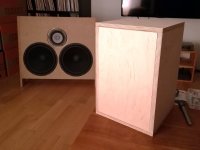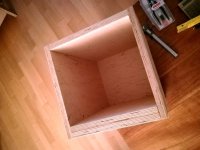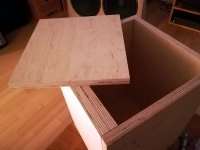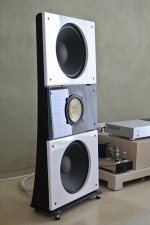Highly appreciated, Jeff. Super Pensils are not completely out of question, but as chris661 has guessed correctly, for now the little reflex versions do have my interest.The Super Pensils are what I'd recommend (as I own a pair), but if you try the small stand mount boxes, you'll want a couple powered subs to fill in the bass.
Interesting idea. Regarding my design, I was in a similar position as G. A. Briggs back then. I liked the ESL, but couldn't afford them. 😉 So I replaced each bass panels with a 15" and the mid-high panel with the Alpair. Only did some basic simulation in Edge and that was it. In fact, I hardly ever see the cones moving, so even a single 15" would probably do just fine. So ...How about mounting the Alpair you have over one 15", offset a bit, and placing the second 15" behind, firing through a slot at the bottom, like in this design that would halve the whole speaker baffle.... Would that still be too big?
... yes, this would probably work for me. But it's not just about the size of the (non-) boxes. It's also about the required wall clearance. The reflex box should work well relatively close to the rear wall, the OBs simply do not.I heard the cabinets Scott posted a photo of.
Nice little boxes. IMO, not the last word in bass extension, but the rest of the range is very good. I liked the slightly laid-back top end, but I can understand why some people add supertweeters.
With regards to your current system, try removing one of the 15"s. If you can live with that, you could almost cut the baffle in half.
You probably got me, I just want to try the Alpair 12P in a small reflex cabinet now. 🙂 Won't throw the Eminence woofers away, though. Adding a ripol sub later would always be an option, if Jeff is right and I'll be missing some low end. Even it this case I would probably go with a single 15" per side first. One reason is, that two Alpha 15a in parallel are not really the perfect match for my Quad 306 power amps, if bass EQ has to be applied. Power output into the resulting 3 ohm minimum is low, 20W/55W continuous/instantaneous. Output into 6 ohm is much better at 40W/95W.I can see that the little bass reflex box has your interest, though, so it might be an interesting thing for you to try.
You could still use the 15"s in some kind of ripole to cover the very low frequencies.
OlavHall, thank you for sharing your experience. Currently I have to move into the opposite direction, though.
Finally made up my mind and I'm going to give Scott's original small reflex box a go (surprise!). Just minor adjustments to material thickness and bracing (see below).
Background: OpenBaffles to be replaced. Foreground: Raw sheets stacked up to mimic the new box.
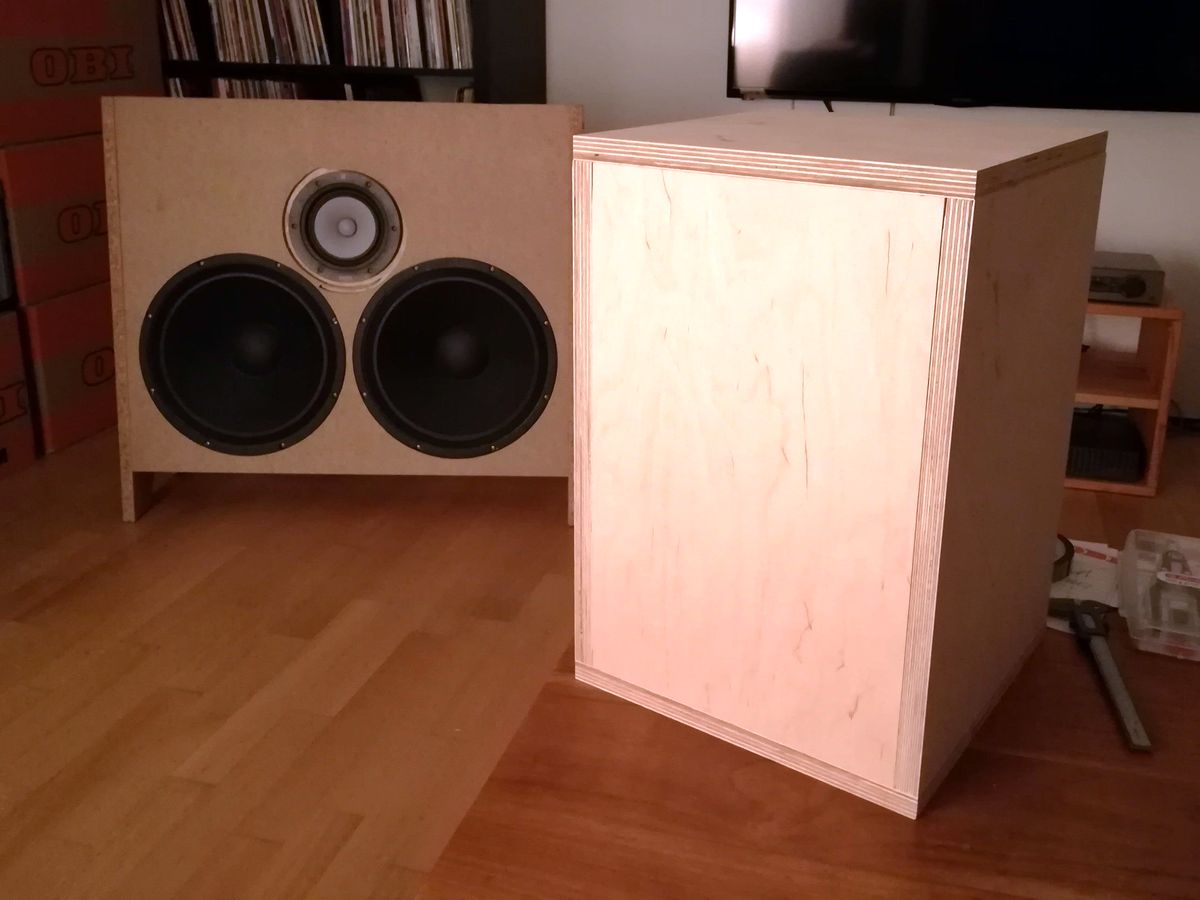
Material of choice is 15mm birch plywood all round. Baffle thickness doubled to 30mm. Certainly not the best quality plywood, as you can see. But it should be sufficient for a proof of concept.
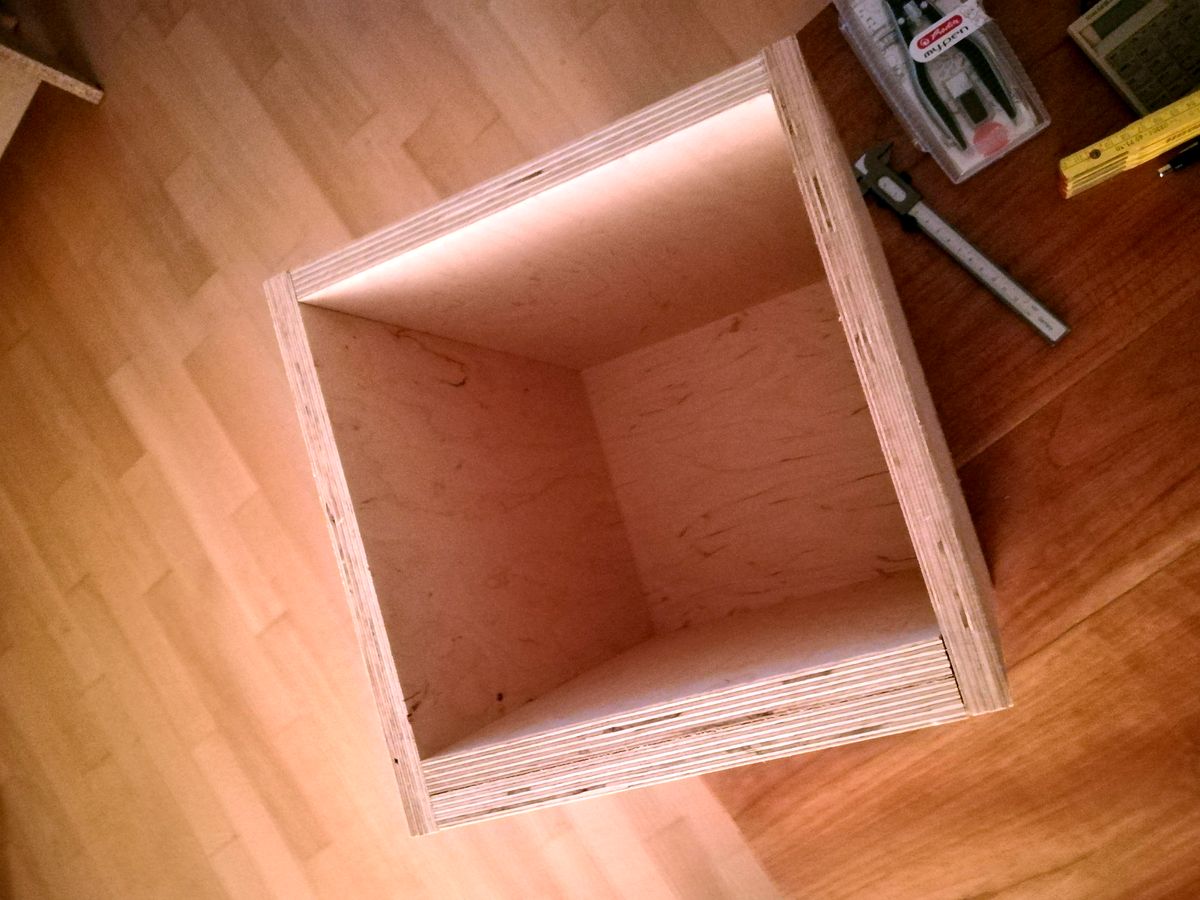
For now I'll be implementing just one horizontal brace right behind the driver with no vertical brace. This stiffens up the "largest" panels (obviously), but - probably even more importantly - supports the magnet and spreads driver induced vibrations.
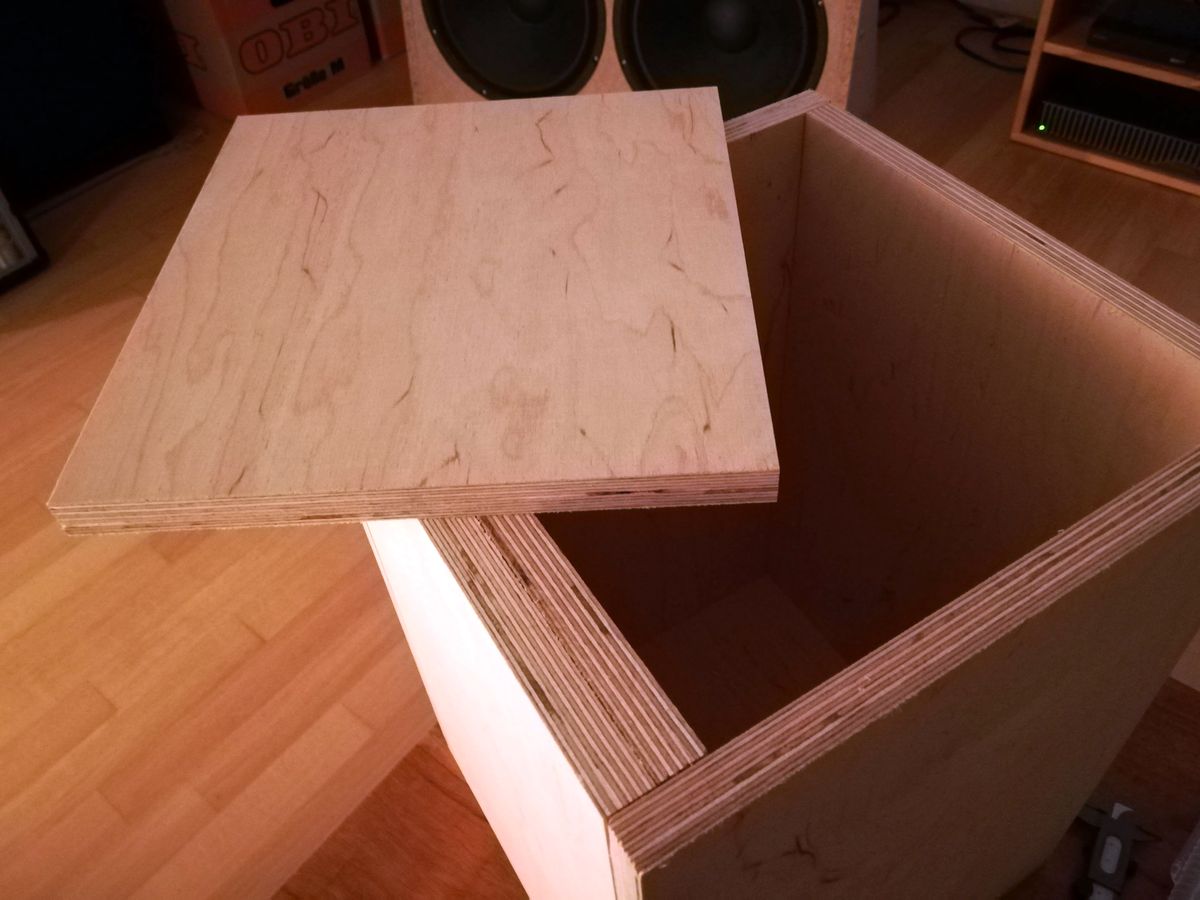
No cutouts yet, whatsoever. But of course they are going to come.
Why didn't I follow my original plan of using 12mm plywood with more extensive bracing? For one I lost a bit of my courage after reading too much about bracing right her in this forum. Plus I wanted a thicker baffle to ensure rigid driver mounting.
Highly braced, stiff cabinets are for subwoofers only, not for fullrange speakers. Bracing reduces the coincidence frequency. Shifting resonances up is always evil (except for subwoofers again), because this makes them more audible. This is what some obviously knowledgeable people seem to imply. After thinking about this for some time, I still think that there is a lot of wrongly applied science circulating. Light and stiff and heavily braced and damped cabinets are after all still what I consider to be the best possible solution. But right now I will go a more conservative way with my prototype speakers. Will be adding some damping to the cabinet walls as well. Let's see how this will turn out.
Background: OpenBaffles to be replaced. Foreground: Raw sheets stacked up to mimic the new box.
Material of choice is 15mm birch plywood all round. Baffle thickness doubled to 30mm. Certainly not the best quality plywood, as you can see. But it should be sufficient for a proof of concept.
For now I'll be implementing just one horizontal brace right behind the driver with no vertical brace. This stiffens up the "largest" panels (obviously), but - probably even more importantly - supports the magnet and spreads driver induced vibrations.
No cutouts yet, whatsoever. But of course they are going to come.
Why didn't I follow my original plan of using 12mm plywood with more extensive bracing? For one I lost a bit of my courage after reading too much about bracing right her in this forum. Plus I wanted a thicker baffle to ensure rigid driver mounting.
Highly braced, stiff cabinets are for subwoofers only, not for fullrange speakers. Bracing reduces the coincidence frequency. Shifting resonances up is always evil (except for subwoofers again), because this makes them more audible. This is what some obviously knowledgeable people seem to imply. After thinking about this for some time, I still think that there is a lot of wrongly applied science circulating. Light and stiff and heavily braced and damped cabinets are after all still what I consider to be the best possible solution. But right now I will go a more conservative way with my prototype speakers. Will be adding some damping to the cabinet walls as well. Let's see how this will turn out.
Attachments
Last edited:
Shifting resonances up is always evil (except for subwoofers again), because this makes them more audible.
Not really. Pushing resonances up in frequency makes them much harder to excite, and if it is never excited it as if it never existed. And the higher Q the potential resonance is, it becomes even harder to excite… to make it go you have to load the panel with a very narrow range of frequencies for a long time, something very rarely seen in music.
dave
PS: your pictures are not showing up.
Not my own reasoning, but what others have said. You've had your fights with some of them, so I don't have to name them.Not really. Pushing resonances up in frequency makes them much harder to excite, and if it is never excited it as if it never existed. And the higher Q the potential resonance is, it becomes even harder to excite… to make it go you have to load the panel with a very narrow range of frequencies for a long time, something very rarely seen in music.
I don't feel prepared to go into more detail here, but I don't even think that the concept of coincidence frequency is applicable to speakers at all, as has been advocated.
Better now? Not happy with attachment handling here.PS: your pictures are not showing up.
Hi everyone,
I'm currently using open baffles with 1 MarkAudio Alpair 12P and 2 Eminence Alpha 15a per side. The chipboard (these "prototypes" ended up serving me well for more than 2 years) was cut to closely mimic the dimensions of the Quad ESL. Add a MiniDSP and a pair of Quad 306: I like what I hear. Problem is depicted in image no. 3: They take up way too much space in my new, much smaller living room. 🙁
...
Today I finished the second baffle, guesstimated from a higher QTS 12 inch full range driver on a folded open baffle, sized for the baffle to act as a highpass.
For these baffles, I eventually cut down to 16 inches wide by 36
3/4" plywood thickened to 1.5" thick where the drivers are.
Not sure if this is small enough for you, but it works mint for me, and using different wiring options, gives me some rudimentary tone control for various sources, 12P by itself, 12P in series with a 12PW, or 12PW by itself.
Any of these sound more natural to me than my original idea of a 12P wired in parallel with a 12PW wired in reverse polarity with a second order passive filter with using a 1.22 ohm air core inductor for added resistance .
About 350 Hz and down added to the output of the unfiltered 12P for a mild boost. This proved unecessary as the baffle size worked as hoped as a simple passive highpass for the satellites to meet a couple of subs I've had for a long time in distributed bass, 4th order lowpassed at about 70 hertz.
They sound better by far than the minimal effort in making them, after a couple of false start prototypes, and even satisfy my inner space cadet by mimicking 2 of 3 of the 2001: A Space Odyssey monolith dimensions of the 1-4-9 ratio.
Last edited by a moderator:
Agreed, make the cab figuratively 'ring like a ten penny nail struck with a ball peen hammer' and we have an acoustically dead cab in any audio speaker's pass band.but I don't even think that the concept of coincidence frequency is applicable to speakers at all
- Home
- Loudspeakers
- Full Range
- Alpair 12P Small Reflex - The world's least popular FR speaker?
